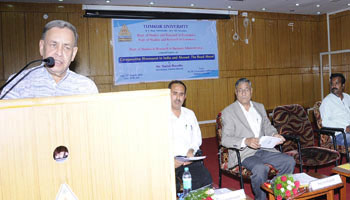Satish Marathe the senior cooperator spoke on the subject “Co Op Movement in India and Abroad: The Road Ahead ” in Tumkar University last weekend. The Special Lecture was jointly organised by the Departments of Commerce, Economics and Management and was attended by Research Scholars, Faculty Students and Delegates from Universities of Karnataka.
Marathe made some interesting points in his rather longish speech. We would feature them part-wise. Here is a verbatim report on his views on cooperative movement in India-Editor
Excerpts:
Co Operatives, as economic enterprises and as self-help organizations, play a meaningful role in uplifting the socio-economic conditions of their members and their local communities. Over the years, Co Operative enterprises have successfully operated as locally owned, people-centric economic enterprises and have served as catalysts for social organization and cohesion. With their concern for their members and communities, they represent a unique model that emphasizes democratic and human values and respect for the environment.
India is a developing country facing number of problems, such as the population explosion, low productivity, inequalities, low living standards, inflation and so on. India consisting of 16% of the world’s population sustains only on 2.4% of land resource. Agriculture sector is the only livelihood to the two-third of its population which gives employment to the 57% of work force and is a source of raw material to large number of industries.
Co Operative movement in India is one of the largest movements in the world. Co Operative movement has made tremendous progress in every aspects of the Indian economy. Co Operative activities occupy a major place in the sphere of the Indian economy. Initially, the Co Operative movement was started with a limited scope of activities of rural credit but now it has entered in all fields of economic activity with social essence. Co Operative sector of Indian economy has always had a spiritual content as it was led by Vinoba Bhave, Vaikunthbhai Mehta and Dhananjayrao Gadgil.
The movement has covered 100 per cent villages and 75 per cent rural households and is functioning through a network of over 6 lacs Co Operatives of various levels with membership coverage of over 25 crores. In fertilizer production and distribution, the Indian Fertilizer Co Operatives command over 58% of the market. In the production of sugar, the market share of Co Operatives is over 58% and in cotton, Co Operatives have a share of 60%. The Co Operative sector accounted for 55% of the looms in the hand-weaving sector.
It has been playing a significant role in disbursing agricultural credit, distribution of agricultural inputs, providing market support, processing, etc. Co Operative movement has been recognized as an effective instrument for the economic development of the rural masses and for improvement in the socio-economic condition of the poor.
Way back in 2002, NABARD in its Annual Report had observed that Co Operatives have contributed significantly to the growth of institutional infrastructure in the rural areas and individual capital formation in the agricultural sector.
The first Co Operative Credit Societies Act was enacted in 1904. Subsequently, a more comprehensive legislation called the Cooperative Societies Act was enacted.
This Act provided for the creation of the post of Registrar of Co Operative Societies for registration of Co Operative Societies, audit, etc. Under the Montague- Chelmsford Reforms of 1919, Co Operation became a provincial subject and provinces were authorized to make their own Co Operative laws. Under the Government of India Act 1935, Co Operatives were treated as a provincial subject. The ‘Co Operative Societies’ is now a State subject under entry No 32 of the State List of the Constitution of India.
The lackluster performance of Co Operatives in India can be attributed to dormant membership and lack of active participation of members in the management of Co Operatives. Mounting overdues in Co Operative Credit Institutions, lack of mobilization of own resources and over dependence on Governmental and Institutional support, lack of professional management, bureaucratic and political control and interference in the management and over-politicization have proved harmful to its growth. These are the areas which need to be attended to by evolving suitable legislative and policy support.
Today a large number of men and women and their families are facing immense hardships. As a result of misconstrued economic policies, weaker segments viz. farmers, workers, tribal, economically backward communities, etc. are facing severe deprivation. The crisis represents the outcome of severe imbalances that have generated inequality and inequity which has led to a strong and growing feeling of injustice and exclusion amongst the underprivileged.
In recent years, the State – Central and State Governments – has consistently refused to recognize the salient characteristics of the Co Operatives and have failed to harness its potential to achieve growth through participation of people.
The 100 years old Co Operative Acts, both, Central and the States, need to be radically redrafted in the changed economic, political and social scenario and create an enabling legal and financial environment to empower the Co Operatives.
With a view to achieve rapid development and social harmony, we need to promote new models of Gen Next Co Operatives.
